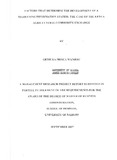| dc.description.abstract | The overall objective of the study was to establish the factors that determine the
development of a marketing information system. The study aimed to support processes and to
provide some insight into the issues, opportunities and limitation regarding the potential role
of MIS in future agricultural sector activities.
A descriptive survey was undertaken. This was a case study of Kenya Agricultural Exchange
(KACE). The population of study was farmers served by KACE and management staff of
KACE located in all the eleven outlets countrywide. A representative sample of 18 members
of staff, who represent 20% of the population and two farmers in each of the outlets were
interviewed making a total of 22 farmers.
A desk study was undertaken by reviewing the relevant literature which included various
websites, books, magazines, journals and available reports from the various government
ministries. The desk study ensured that the research did not duplicate other studies, and
instead make a significant contribution toward the subject of study.
The data was analyzed by employing descriptive statistics such as percentages, frequencies
and tables. Statistical Package for Social Sciences (SPSS) was used to aid in analysis.
Computation of frequencies in tables, charts and bar graphs was used in data presentation.
The information was presented and discussed as per the objectives and research questions of
the study.
Findings of the study indicate that when it is in line with their business strategies, private
companies can also develop MIS, which benefits poor farmers with a high chance of success
and sustainability. However, the information quality and its usefulness to the users need to be
continuously assessed and improved. Member based organizations also find it appropriate to manage MIS to offer marketing information to their members in exchange of the membership
fee and members‟ support.
The project report is structured into five chapters as follows:- Chapter one covers the
introduction, chapter two presents the literature review while chapter three presents the
methodology of the study. Chapter four presents the findings of the study while chapter five
presents a summary of the findings, conclusions and recommendations | en |

